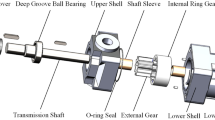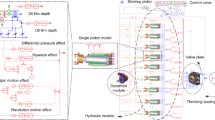Abstract
The current research about the flow ripple of axial piston pump mainly focuses on the effect of the structure of parts on the flow ripple. Therein, the structure of parts are usually designed and optimized at rated working conditions. However, the pump usually has to work in large-scale and time-variant working conditions. Therefore, the flow ripple characteristics of pump and analysis for its test accuracy with respect to variant steady-state conditions and transient conditions in a wide range of operating parameters are focused in this paper. First, a simulation model has been constructed, which takes the kinematics of oil film within friction pairs into account for higher accuracy. Afterwards, a test bed which adopts Secondary Source Method is built to verify the model. The simulation and tests results show that the angular position of the piston, corresponding to the position where the peak flow ripple is produced, varies with the different pressure. The pulsating amplitude and pulsation rate of flow ripple increase with the rise of pressure and the variation rate of pressure. For the pump working at a constant speed, the flow pulsation rate decreases dramatically with the increasing speed when the speed is less than 27.78% of the maximum speed, subsequently presents a small decrease tendency with the speed further increasing. With the rise of the variation rate of speed, the pulsating amplitude and pulsation rate of flow ripple increase. As the swash plate angle augments, the pulsating amplitude of flow ripple increases, nevertheless the flow pulsation rate decreases. In contrast with the effect of the variation of pressure, the test accuracy of flow ripple is more sensitive to the variation of speed. It makes the test accuracy above 96.20% available for the pulsating amplitude of pressure deviating within a range of ±6% from the mean pressure. However, with a variation of speed deviating within a range of ±2% from the mean speed, the attainable test accuracy of flow ripple is above 93.07%. The model constructed in this research proposes a method to determine the flow ripple characteristics of pump and its attainable test accuracy under the large-scale and time-variant working conditions. Meanwhile, a discussion about the variation of flow ripple and its obtainable test accuracy with the conditions of the pump working in wide operating ranges is given as well.
Similar content being viewed by others
References
IVANTYSYNOVA M, HUANG Changchun, CHRISTIANSEN S K. Computer aided valve plate design: An effective way to reduce noise[J]. SAE Transactions, 2004, 113(2): 162–173.
IVANTYSYNOVA M, SEENIRAJ G K, HUANG Changchun. Comparison of different valve plate designs focusing on oscillating forces and flow pulsation[C]//The Ninth Scandinavian International Conference on Fluid Power, SICFP’05, Linköping University, Sweden, June 1–3, 2005: 62–68.
MANDAL N P, SAHA R, SANYAL D. Theoretical simulation of ripples for different leading-side groove volumes on manifolds in fixed-displacement axial-piston pump[J]. Proceedings of the Institution of Mechanical Engineers, Part I: Journal of Systems and Control Engineering, 2008, 222(I6): 557–570.
MANDAL N P, SAHA R, SANYAL D. Effects of flow inertia modelling and valve-plate geometry on swash-plate axial-piston pump performance[J]. Proceedings of the Institution of Mechanical Engineers, Part I: Journal of Systems and Control Engineering, 2012, 226(I4): 451–465.
SONG Y C, XU B, YANG H Y. Study on Effect of relief groove angle expressing the position in reducing noise of swash plate axial piston pump[J]. Advanced Materials and Processes, 2011, 311–313: 2215–2224.
SEENIRAJ G K. Model based optimization of axial piston machines focusing on noise and efficiency[D]. USA: West Lafayette, Indiana, 2009.
NIMAI P, MANDAL R S, DIPANKAR S. Valve plate design of a swash plate type and axial piston pump through theoretical simulation of flow dynamics[C]//The 7th International Fluid Power Conference, Aachen University of Technology, Germany, 2010. Aachen: IFK, 2010: 253–259.
GUAN C B, JIAO Z X, HE S Z. Theoretical study of flow ripple for an aviation axial-piston pump with damping holes in the valve plate[J]. Chinese Journal of Aeronautics, 2014, 27(1): 169–181.
MANDAL N P, SAHA R, SANYAL D. Theoretical simulation of ripples for different leading-side groove volumes on manifolds in fixed-displacement axial-piston pump[J]. Proc IMechE, Part I: J. Systems and Control Engineering, 2008, 222: 557–570.
GUAN C B, JIAO Z X. Dynamic optimization method for valve plate structure of aviation piston pump[J]. Journal of Beijing University of Aeronautics and Astronautics, 2011, 37(3): 274–278.
EDGE K A, DARLING J. The pumping dynamics of swash plate piston pumps[J]. Journal of Dynamic systems, Measurement and Control, 1989, 111: 307–312.
MANRING N D. The discharge flow ripple of an axial-piston swash-plate type hydrostatic pump[J]. Trans. ASME, J. Dynamic Systems, Measmt, and Control, 2000, 122: 263–268.
MA J E, XU B, ZHANG B, et al. Flow ripple of axial piston pump with computational fluid dynamic simulation using compressible hydraulic oil[J]. Chinese Journal of Mechanical Engineering, 2010, 23(1): 45–52.
SHI Z R, PARKER G, GRANSTROM J. Kinematic analysis of a swash-plate controlled variable displacement axial-piston pump with a conical barrel assembly[J]. Journal of Dynamic Systems Measurement and Control-Transactions of the ASME, 2010, 132(1): 0110021–0110028.
LEI L, JIAN K, XU J, et al. Discharge flow ripple of axial piston pump with conical cylinder block[J]. Applied Mechanics and Materials, 2010, 34–35: 440–445.
MA J E, FANG Y T, XU B, et al. Optimization of cross angle based on the pumping dynamics model[J]. Journal of Zhejiang University-Science A, 2010, 11(3): 181–190.
WEI X Y, WANG H Y. The influence of cross angle on the flow ripple of axial piston pumps by CFD simulation[J]. Advances in Manufacturing Technology, 2012, 220–223: 1675–1678.
XU B, SONG Y C, YANG H Y. Optimization of swash-plate cross angle noise-reduction structure for swash-plate-type axial piston pump[J]. Journal of Zhejiang University (Engineering Science), 2013, 47(6): 1043–1050. (in Chinese)
ERICSON L, JOHANSSON A, PALMBERG J O. Noise reduction by means of non-uniform placement of pistons in a fluid power machine[C]//Proceedings of the ASME 2009 Dynamic Systems and Control Conference, Hollywood, California, USA, October 12–14, 2009, New York: ASME, 2009: 1–8.
MEHTA V S, MANRING N D. Piston pump noise attenuation through modification of piston travel trajectory[C]//Proceedings of the ASME 2010 International Mechanical Engineering Congress and Exposition (IMECE2010), Vancouver, British Columbia, Canada, 2010, New York: ASME, 2010: 1–9.
BERGADA J M, KUMAR S, DAVIES D L, et al. A complete analysis of axial piston pump leakage and output flow ripples[J]. Applied Mathematical Modelling, 2012, 36(4): 1731–1751.
XU B, SONG Y C, YANG H Y. Pre-compression volume on flow ripple reduction of a piston pump[J]. Chinese Journal of Mechanical Engineering, 2013, 26(6): 1259–1266.
XU B, ZHANG J H, YANG H Y. Simulation research on distribution method of axial piston pump utilizing pressure equalization mechanism[J]. Proceedings of the Institution of Mechanical Engineers Part C-Journal of Mechanical Engineering Science, 2013 227(C3): 459–469.
LISELOTT E. Movement of the swash plate in variable in-line pumps at decreased displacement setting angle[C]//22nd International Congress of Mechanical Engineering (COBEM 2013), Ribeirão Preto, SP, Brazil, November 3–7, 2013: 8055–8064.
EDGE K A, JOHNSTON D N. The ‘secondary source’ method for the measurement of pump pressure ripple characteristics Part 1. Description of method[J]. Proceedings of the Institution of Mechanical Engineers, Part A. Journal of Power and Process Engineering, 1990, 204(11): 33–40.
EDGE K A, JOHNSTON D N. The ‘secondary source’ method for the measurement of pump pressure ripple characteristics Part 2: Experimental results[J]. Proceedings of the Institution of Mechanical Engineers, Part A. Journal of Power and Energy, 1990, 204(11): 41–46.
KASSEM S A, BAHR M K. On the dynamics of swash plate axial piston pumps with conical cylinder blocks[C]//Sixth Triennial International Symposium on Fluid Control Measurement and Visualization, Sherbrooke University, Sherbrooke, Canada, 2000: 13–17.
JOHANSSON A, ÖVANDER J, PALMBERG J O. Experimental verification of cross-angle for noise reduction in hydraulic piston pumps[J]. IMechE, Part I: System and Control Engineering, 2007, 221: 321–330.
ZHANG B, XU B, XIA C L, et al. Modeling and simulation on axial piston pump based on virtual prototype technology[J]. Chinese Journal of Mechanical Engineering, 2009, 22(1): 84–90.
XU B, SONG Y C, YANG H Y. Investigation of test principle of flow ripple generated by piston pump with complicated pipe[J]. Journal of Mechanical Engineering, 2012, 48(22): 162–167. (in Chinese)
SONG Y C, XU B, YANG H Y, et al. Modified practical approximate method for testing source flow of piston pump[J]. Journal of Zhejiang University (Engineering Science), 2014, 48(2): 200–205. (in Chinese)
ROELANDS C J A. Correlational aspects of the viscosity-temperature-pressure relationship of lubricating oils[D]. Druk. U. R. B., Groningen, 1966.
ZHANG B. Virtual prototype and experimental study on acting oil film of axial piston pump[D]. Hangzhou: Zhejiang University, 2009.
The International Organization for Standardization, 1996. “ISO 10767-1-1996 Hydraulic Fluid Power - Determination of Pressure Ripple Levels Generated in System and Components. Part 1: Precision method for pumps”[S]. London: British Standards Institution, 1996.
YANG H Y, MA J E, XU B. Research status of axial piston pump fluid-borne noise[J]. Journal of Mechanical Engineering, 2009, 45(8): 71–79. (in Chinese)
Author information
Authors and Affiliations
Corresponding author
Additional information
Supported by National Basic Research Program of China (973 Program, Grant No. 2014CB046403), and National Key Technology R&D Program of the Twelfth Five-year Plan of China (Grant No. 2013BAF07B01)
XU Bing, born in 1971, is a professor at State Key Laboratory of Fluid Power Transmission and Control, Zhejiang University, China. His main research interests include mechatronics control, fluid power components and systems.
HU Min, born in 1985, is currently a PhD candidate at State Key Laboratory of Fluid Power Transmission and Control, Zhejiang University, China. His research interests include axial piston pump and energy efficiency.
ZHANG Junhui, born in 1984, obtained his PhD degree from Zhejiang University, China, in 2013. His research interests include axial piston pump and fluid born noise control.
Rights and permissions
About this article
Cite this article
Xu, B., Hu, M. & Zhang, J. Impact of typical steady-state conditions and transient conditions on flow ripple and its test accuracy for axial piston pump. Chin. J. Mech. Eng. 28, 1012–1022 (2015). https://doi.org/10.3901/CJME.2015.0703.085
Received:
Revised:
Accepted:
Published:
Issue Date:
DOI: https://doi.org/10.3901/CJME.2015.0703.085




